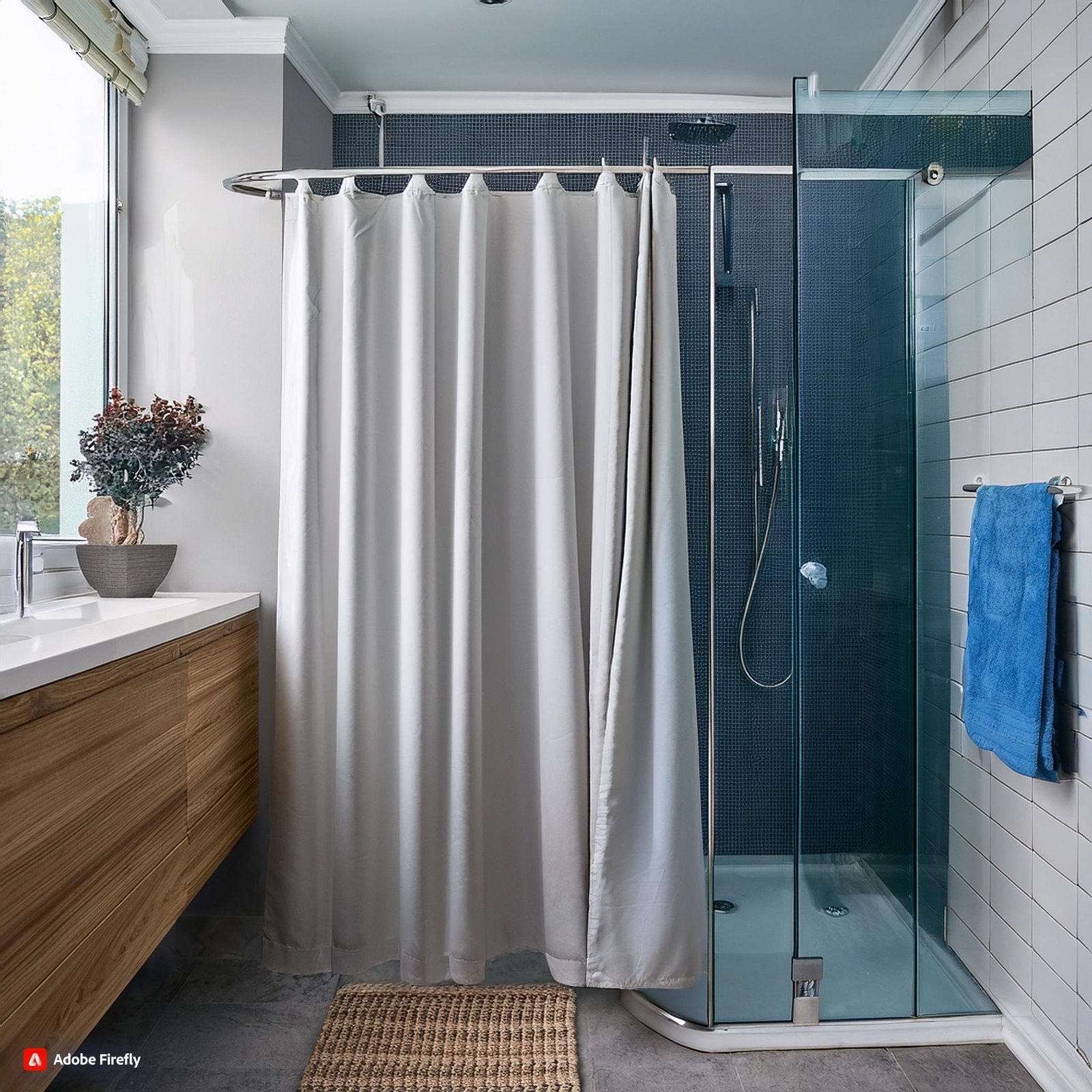Shower Curtain Size Guide: Finding the Perfect Fit for Your Bathroom
A shower curtain is more than just a functional accessory in your bathroom; it’s an opportunity to enhance the overall aesthetic of your space. However, selecting the correct shower curtain size ensures both style and practicality. In this comprehensive Shower Curtain Size Guide, we’ll walk you through everything you need to know to choose the perfect shower curtain for your bathroom.
Home Improvements: Your Ultimate Guide to Transforming Your Living Space
Why Shower Curtain Size Matters
Choosing the wrong size for your shower curtain can lead to various issues, from a cramped look to water leaking onto your bathroom floor. A well-fitted shower curtain contains water effectively and adds a polished look to your bathroom. With various sizes available, understanding how to measure your space and select the correct dimensions is essential.
Standard Shower Curtain Sizes
Shower curtains typically come in four main sizes: standard, extra tall, extra wide, and extra wide + tall. Let’s explore each of these options in detail:
- Standard Size (72” x 72”): The most common shower curtain size, 72” x 72”, is designed to fit most standard-sized shower/tub combinations. This size provides adequate coverage for around 60-66 inches wide showers.
- Extra Tall Size (72” x 84”): If you have a taller shower area or prefer a curtain that hangs closer to the floor, the extra tall size is ideal. With a height of 84 inches, this curtain adds a dramatic touch to your bathroom and works well for showers with higher ceilings.
- Extra Wide Size (84” x 72”): The extra wide size provides the necessary coverage for those with more expansive showers or bathtub enclosures. Measuring 84 inches in width, this curtain is perfect for ensuring no water escapes the shower area.
- Extra Wide + Tall Size (84” x 84”): The largest option available is wide and tall, making it suitable for expansive shower spaces or custom-built showers requiring extensive coverage.
How to Measure Your Shower for the Perfect Fit
To find the perfect shower curtain size, follow these three essential steps:
Step 1: Choose Your Width
Start by measuring the width of your shower from wall to wall. Adding an extra 12 inches to this measurement is important to allow the curtain to drape nicely when closed rather than being stretched tight across the shower opening. This additional width creates a more relaxed and aesthetically pleasing look.
For example, if your shower measures 60 inches wide, adding 12 inches gives you 72 inches, which is the perfect width for a standard shower curtain. If your shower measures closer to 72 inches wide, an extra wide curtain of 84 inches would be a better fit.
Step 2: Find Your Length
Next, measure the distance from the curtain rod to the floor. You don’t want the curtain to touch the floor, which can lead to mold and mildew growth. To achieve the right length, subtract 8-10 inches from the rod-to-floor measurement. This ensures that the curtain hangs just above the floor, preventing water from escaping while keeping the curtain clean and dry.
For most showers, a standard length of 72 inches will suffice. However, if your shower rod is installed higher or you have a taller shower area, you might need a curtain with an 84-inch length.
Step 3: Add a Liner and Accessories
Always use a liner to protect your shower curtain and prolong its life. The liner should be the same size as the curtain or slightly smaller. This ensures the liner stays hidden behind the curtain, preventing water from seeping through.
When hanging the curtain, consider using roller rings, which allow the curtain to glide smoothly along the rod. Shower curtains typically come with buttonholes at the top for attaching the rings. A 72-inch-wide curtain usually has 12 buttonholes, while an 84-inch-wide curtain has 15. Make sure to choose a rod that complements the size and style of your curtain for a cohesive look.
Special Considerations for Different Shower Types
Different types of showers require different curtain sizes and styles. Here’s how to choose the right curtain for your specific shower type:
- Corner Showers
Corner showers often have unique dimensions, requiring custom-sized curtains. Measure the width and length carefully, as these showers may need a curtain that wraps around two or more sides. Look for adjustable rods that fit snugly in the corner, and choose a curtain size that provides adequate coverage.
- Curved Shower Rods
Curved shower rods are famous for adding extra elbow room, but they also require a wider curtain. Measure the curve from one end to the other, and select a wide enough curtain to follow the rod’s contour without leaving gaps.
- Freestanding Tubs
Freestanding tubs often have shower heads above them, necessitating a curtain surrounding the entire tub. In this case, you’ll need a circular rod and a curtain that is wide and long enough to cover all sides of the tub. Consider using multiple curtains to achieve full coverage without compromising on style.
Understanding Shower Curtain Rod Sizes
While choosing the right curtain size is crucial, it’s equally important to consider the size and style of your shower curtain rod. The rod is the foundation for your curtain, and choosing the right one ensures a secure fit and easy operation.
Standard Rod Length
The standard length for a shower curtain rod is between 60 and 72 inches. This size works well for most showers and bathtubs, providing enough space for the curtain to move freely. However, if you have a more expansive shower or use a curved rod, you may need a longer rod, typically between 72 and 84 inches.
Adjustable Rods
Adjustable rods are a versatile option that can be customized to fit various shower sizes. These rods can be extended or shortened to fit the exact width of your shower, ensuring a snug fit. They’re also easy to install and often come with tension mechanisms, eliminating the need for drilling holes in your bathroom walls.
Fixed Rods
Fixed rods offer a more permanent solution and are usually installed using brackets that are screwed into the wall. These rods are available in various lengths and finishes, allowing you to choose one that complements your bathroom décor. While they require more effort, fixed rods provide a sturdy and reliable option for hanging your shower curtain.
Popular Materials for Shower Curtains
When selecting a shower curtain, the material is as important as the size. Different materials offer varying levels of durability, water resistance, and style. Here are some of the most popular options:
- Polyester
Polyester is a common material for shower curtains due to its water-resistant properties and affordability. It’s easy to clean, typically machine-washable, and available in various colors and patterns. Polyester curtains are a practical choice for most bathrooms and can be paired with a liner for added protection.
- Vinyl
Vinyl shower curtains are water-resistant and often come in transparent or translucent styles. They’re a budget-friendly option and easy to clean, making them ideal for busy households. However, vinyl curtains may not be as stylish or durable as fabric options, and they can develop mildew over time if not properly maintained.
- Cotton
Cotton shower curtains offer a soft, luxurious feel and are available in various designs. While not inherently water-resistant, cotton curtains can be used with a liner to prevent water from soaking through. They’re machine-washable and add a touch of elegance to any bathroom, but they may require more maintenance to keep them looking fresh.
- Linen
Linen curtains are a premium option that adds a sophisticated, natural look to your bathroom. Like cotton, linen is not water-resistant, so a liner is necessary. Linen curtains are breathable and resistant to mildew but require careful cleaning to maintain their appearance.
Accessories to Complement Your Shower Curtain
Once you’ve selected the perfect shower curtain, consider adding accessories to complete the look and enhance functionality. Here are some popular options:
Shower Curtain Rings
Rings or hooks are essential for hanging your shower curtain. Roller rings are popular because they allow the curtain to glide smoothly along the rod, reducing wear and tear. Choose rings that match the finish of your shower rod and other bathroom fixtures for a cohesive look.
Shower Curtain Liners
As mentioned earlier, a liner is crucial for protecting your curtain and preventing water from escaping the shower. Liners are available in various materials, including vinyl and polyester, and can be transparent or opaque. Look for a liner with magnets or weights at the bottom to keep it in place.
Shower Curtain Rods
If you want to update your bathroom, consider replacing your shower curtain rod with a new one that better suits your style. Options include tension, fixed, and curved rods, each offering different benefits depending on your needs.
Hooks and Holdbacks
Hooks and holdbacks can tie back the curtain when not in use, adding a decorative touch to your bathroom. They’re available in various styles, from simple metal hooks to ornate designs that complement your curtain and rod.
Final Thoughts: Making the Right Choice for Your Bathroom
Selecting the perfect shower curtain size involves more than just picking a design you love. It requires careful measurement and consideration of your bathroom’s layout, shower type, and overall look you want to achieve. Following this Shower Curtain Size Guide, you can confidently choose a curtain that fits your space perfectly, enhances your bathroom’s décor, and provides the necessary functionality.
Whether you’re renovating your bathroom or simply updating your shower curtain, taking the time to measure and select the correct size will make a significant difference in the overall feel of your space. Remember to pair your curtain with a quality liner, choose the right accessories, and consider the type of shower rod that best suits your needs.
Frequently Asked Questions (FAQs)
1. What are the standard shower curtain sizes?
- The standard shower curtain sizes are 72” x 72” for most showers, 72” x 84” for extra tall showers, 84” x 72” for extra wide showers, and 84” x 84” for extra wide and tall showers.
2. How do I measure for a shower curtain?
- Measure the width of your shower from wall to wall and add 12 inches to find the ideal curtain width. Measure the distance from the curtain rod to the floor and subtract 8-10 inches to find the right length.
3. What is the average size of a shower curtain rod?
- The average size of a shower curtain rod is between 60 and 72 inches, but rods can be longer for more expansive showers or curved designs.
4. Should the shower curtain touch the floor?
- No, the shower curtain should not touch the floor. It should hang 8-10 inches above the floor to prevent water from splashing out and to avoid mold and mildew.
5. What type of liner should I use with my shower curtain?
- Use a liner the same size or slightly smaller than your curtain. Options include vinyl for high water resistance and polyester for a softer, more fabric-like feel.
By understanding the different sizes and options available, you can make an informed decision that will improve your shower experience and elevate the look of your bathroom. Happy decorating!










